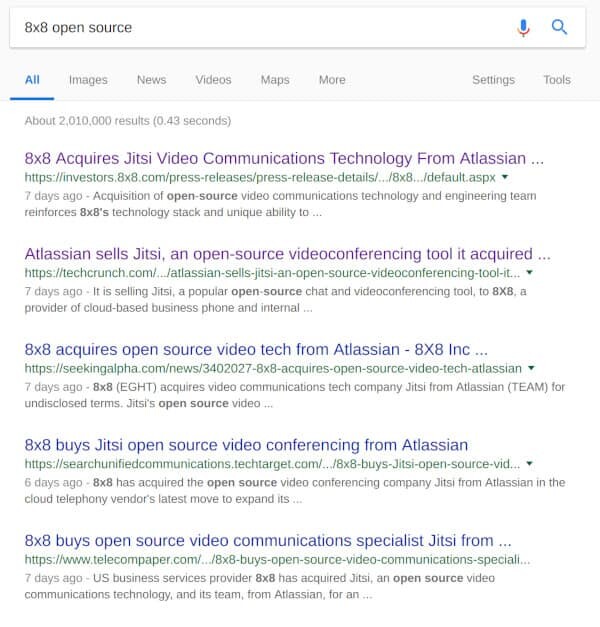Jitsi was just acquired by 8×8, shifting hands from Atlassian. Here’s what to expect.

It seems that Jitsi has now switched hands, moving from Atlassian to 8×8.
Three months ago, Atlassian made a bold (desperate?) decision. It put up a white flag, decided to kill Stride, after investing in it huge amounts of money and resources, throw Hipchat along with it, and “sell” them to Slack, who “acquired” them.
The weird thing in this acquisition was that Jitsi was left behind.
Jitsi is an open source media framework. One of the most popular WebRTC frameworks out there. I wrote about that acquisition in 2015. The reason behind it was Atlassian’s need to own the video communications technically that powered Hipchat. And now that Hipchat is gone, what would Atlassian need Jitsi for?
The last 3 years
The last 3 years have been good for Jitsi in Atlassian.
The team of developers it had was big, considering its scope (and open-sourceness). Especially if you factor in the fact that everything that Hipchat (and Stride) needed from Jitsi was implemented directly inside Jitsi. Not on a private branch of the project available only to Atlassian.
Compare it to how Twilio treated Kurento after its acquisition… Atlassian did a great job at keeping Jitsi’s momentum and community. At the very least, it didn’t hurt the project, letting it grow and flourish, paying the salaries of its developers.
The interesting initiative that took place alongside the Jitsi open source project is Jitsi Meet – a free version of a group video calling service. One that wasn’t limited to a small number of participants or lower video resolutions.
Jitsi is in a better place than it were 3 years ago prior to its acquisition.
Leaving Atlassian
Leaving Atlassian was a matter of time.
There was no room in today’s Atlassian for an open source project like Jitsi that brings no added value to its commercial products.
Jitsi didn’t go to Slack as part of the Hipchat/Stride deal. Slack were already using Janus, and moving on to their own homegrown media server – something they shared with us at Kranky Geek 2017 (hint: come and join us this year at Kranky Geek 2018). There was no reason for them to further invest in yet another migration – or they might have wanted to migrate to Jitsi and acquihire the team but it didn’t pan out.
That left Atlassian with one of 3 alternatives:
- Kill the project and be done with it. Send the developers home or integrate them into some other parts of Atlassian. It would work nicely, but if the asset can be sold, then why not recoup some money?
- Spin out the project. Let the team go, giving them back ownership of the code, and have them go scrape for a livelihood around Jitsi. Probably by offering a commercial license, support and customization services, etc. – this isn’t that far out as an idea – it is how Janus (another open source media framework) operates today and how Jitsi operated prior to its acquisition by Atlassian
- Sell it to someone who’s interested in it. This is what it ended up doing. Given the other alternatives in front of them, I tend to agree with Andy’s statement that this is a mercy sale
Joining 8×8
8×8 acquiring Jitsi is an interesting choice.
Here’s where things get interesting:
8×8 already has a WebRTC based web conferencing solution called “8×8 Virtual Office Meetings Online”. Somewhere in 2016, this service got rewritten. At some point between then and now, guest access on Chrome was introduced. From the looks of it, based on WebRTC.
Why would 8×8 need/want Jitsi when it had a solution already?
I can think of three possible reasons for it:
- Their WebRTC solution isn’t that good, too expensive, and they were looking for a better alternative. Jitsi was a catch in such a case
- 8×8 is looking to own its video technology and not use third party software, commercial or open source
- They were using Jitsi for their 8×8 meetings thingy and Atlassian selling that assent was an opportunity for them to control the tech stack without relying on a third party – probably on the cheap
What would 8×8 do with Jitsi?
The obvious thing is to integrate the tech into its meetings service. If it is already there, then use the Jitsi team of developers to tweak and finetune the thing for the 8×8 use case.
If it isn’t there yet, then integrate it and replace its current WebRTC tech in the meetings app. This is a more challenging undertaking, as Jitsi will need to meet the current feature list of what 8×8 already has in that domain, along with integrating to an existing codebase of a service and an application.
Jitsi probably has most of the needed features to make this happen. It wouldn’t have been acquired otherwise.
On a different area, 8×8 has no real open source activity at the moment. Its github account is mostly forked repos. Searching for “8×8 open source” is dominated by the Jitsi acquisition news:

(the rest are comparisons to other vendors, who are leaning more heavily on open source)
If 8×8 is interested in embracing open source, then it just got an interesting opportunity to do just that. While brings me to the last topic –
The future of Jitsi
What will be of Jitsi?
Here we need to look at Jitsi and Jisti Meet separately.
Jitsi
The Jitsi Videobridge, along with its derivatives, add ons, plugins, extensions and client-side SDKs.
That’s the open source part of the project. At Atlassian, there was nothing kept for internal use of Hipchat/Stride. Everything found its way back to the open source project.
Will 8×8 continue in that path?
Their focus in the coming months is going to be the integration of Jitsi into their 8×8 meetings service. They are bound to use the resources of the Jitsi team to do that.
Managers may decide to implement some of the features in the 8×8 meetings service moving forward and not invest in adding it to the Jitsi open source project. Or they might decide to add everything via Jitsi.
8×8 might end up taking the extreme – ditching the Jitsi project as an open source one – embed it into their meetings app and from there on, invest in that privat branch only. I see that as a highly unlikely outcome in the next 2-3 years.
Time will tell which direction is taken.
Jitsi Meet
Jitsi Meet is a different story altogether.
It is a group video meeting service. One which doesn’t limit the users’ bitrate in sessions, doesn’t limit the number of users in a session, offers mobile apps, Slack and calendar integration and scales globally. All for free.
Would 8×8 see it as competition to their own 8×8 meetings app? If it grows in popularity and its maintenance costs increase, how happy would 8×8 be in paying the bills? Would it see Jitsi Meet as a sales tool for its other services? How would it measure the success of this service?
Whatsapp’s founders just left Facebook this year. It was over disputes about data, privacy and such. Most of all, it was probably a dispute around the future of Whatsapp and Facebook’s intent of monetizing the asset. The same (at a much smaller scale) can happen here at some point.
How would 8×8 monetize Jitsi Meet? Should it? If it doesn’t, should it kill it?
I don’t know the answers. I am sure 8×8 doesn’t either. It is just too early to tell.
Last Words
Jitsi is an open source success story in WebRTC. There’s no doubt about it.
It is now entering a new chapter in its life, under 8×8.
I wish the team the best of luck and us as an industry to have the option to use Jitsi for our future projects.
Media Frameworks are part of the picture of the backend story of WebRTC. Care to learn the rest? Try out my free mini-video series on WebRTC backedn servers:
